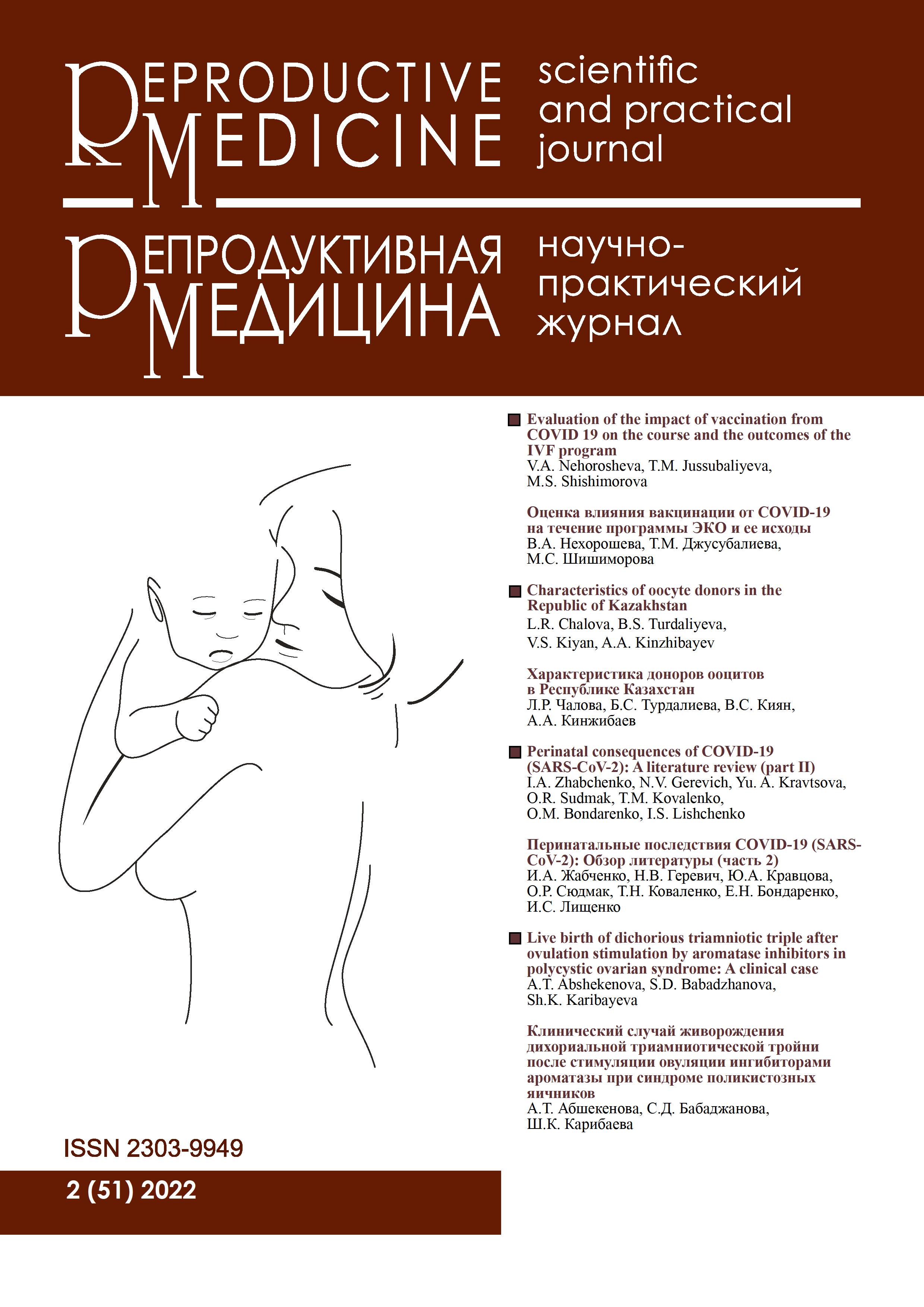The role of the vaginal microbiota in the preservation of female reproductive health: A literature review (part 2)
DOI:
https://doi.org/10.37800/RM.2.2022.45-54Keywords:
microbiome, vaginal microbiota, types of microbial communities, vaginal dysbiosis, bacterial vaginosis, vulvovaginal candidiasis, probiotics, menopausal hormone therapyAbstract
Relevance: The vaginal microbiota plays an important role in host defense against various infectious and non-infectious gynecological diseases. The emergence of new molecular genetic diagnostic methods and the development of computer technologies significantly expand our understanding of the vaginal microbiome, and the current classification of types of microbial communities opens up new perspectives in the diagnosis and treatment of diseases of the female genital area.
The purpose of the study is to analyze current data on the state of the vaginal microbiota, types of microbial communities, and their impact on women’s reproductive health.
Methods: For the review (Parts 1 and 2), the search for scientific literature over the past decade was done on PubMed by
the following keywords: “vaginal microbiome,” “vaginal microbiota,” “vaginal dysbiosis,” “bacterial vaginosis,” “bacterial
vaginosis and age, bacterial vaginosis and ethnicity, bacterial vaginosis and stress, bacterial vaginosis and pelvic inflammatory
disease, bacterial vaginosis, pregnancy, preterm birth, probiotics, and vaginal microbiota, menopausal hormone therapy, and
vaginal microbiota. The article includes original articles and reviews from peer-reviewed publications indexed by PubMed. The
first part of the review was published in Reproductive Medicine No.1, 2022.
Results: In the second part of the literature review, diseases associated with bacterial vaginosis (BV) were considered. BV is the most common variant of vaginal dysbiosis. Its cure rate ranges from 50% to 80% after treatment with metronidazole,
and relapses are frequent. This urges us to identify risk factors and search for more effective treatments. Particular attention is paid to the potential impact on the composition of the vaginal microbiota of diet, probiotics, contraceptives, and menopausal hormone therapy (MHT). This article discusses therapeutic strategies, including the use of probiotics, to maintain or restore a healthy microbiome.
Conclusion: The use of probiotics to restore a functional vaginal microbiome warrants their regulation as medicines, not as food or supplements. Further research should focus on aspects such as finding different effective combinations of strains of probiotic species in the restoration of the vaginal microbiota, consensus on the duration of treatment with probiotics and the number of colony-forming units, and evaluating the effectiveness of the combined use of antibiotics and probiotics.
References
Клинические рекомендации по диагностике и лечению заболеваний, сопровождающихся патологическими выделениями из половых путей женщин. РОАГ, 2019 // www.medkirov.ru/docs/id/4F7915/$File/Клинические%20рекомендации%20по%20диагностике%20и%20лечению%20заболеваний%2C%20сопровождающихся%20патологическими%20выделениями.pdf (30.01.2022).
Sanchez-Garcia E.K., Contreras-Paredes A., Martinez-Abundis E., Garcia-Chan D., Lizano M., de la Cruz-Hernandez E. Molecular epidemiology of bacterial vaginosis and its association with genital micro-organisms in asymptomatic women // J. Med. Microbiol. – 2019. – Vol. 68. – P. 1373–1382. https://doi.org/10.1099/jmm.0.001044.
Barrientos-Durán A., Fuentes-López A., De Salazar A., Plaza-Díaz J., García F. Reviewing the Composition of Vaginal Microbiota: Inclusion of Nutrition and Probiotic Factors in the Maintenance of Eubiosis // Nutrients. – 2020. – Vol. 12(2). – P. 419. https://doi.org/10.3390/nu12020419.
Brotman R.M., Bradford L.L., Conrad M., Gajer P., Ault K., Peralta L., Forney L.J., Carlton J.M., Abdo Z., Ravel J. Association between Trichomonas vaginalis and vaginal bacterial community composition among reproductive-age women // Sex. Transm. Dis. – 2012. – Vol. 39. – P. 807–812. https://doi.org/10.1097/OLQ.0b013e3182631c79.
Fastring D.R., Amedee A., Gatski M., Clark R.A., Mena L.A., Levison J., Schmidt N., Rice J., Gustat J., Kissinger P. Co-occurrence of Trichomonas vaginalis and bacterial vaginosis and vaginal shedding of HIV-1 RNA // Sex. Transm. Dis. – 2014. – Vol. 41. – P. 173–179. https://doi.org/10.1097/OLQ.0000000000000089.
Sabo M.C., Lehman D.A., Wang B., Richardson B.A., Srinivasan S., Osborn L., Matemo D., Kinuthia J., Fiedler T.L., Munch M.M., Drake A.L., Fredricks D.N., Overbaugh J., John-Stewart G., McClelland R.S., Graham S.M. Associations between vaginal bacteria implicated in HIV acquisition risk and proinflammatory cytokines and chemokines // Sex. Transm. Infect. – 2019. https://doi.org/10.1136/sextrans-2018-053949.
Esber A., Vicetti Miguel R.D., Cherpes T.L., Klebanoff M.A., Gallo M.F., Turner A.N. Risk of bacterial vaginosis among women with herpes simplex virus type 2 infection: A systematic review and meta-analysis // J. Infect. Dis. – 2015. – Vol. 212. – P. 8–17. https://doi.org/10.1093/infdis/jiv017.
Abbai N.S., Nyirenda M., Naidoo S., Ramjee G. Prevalent herpes simplex virus-2 increases the risk of incident bacterial vaginosis in women from South Africa // AIDS Behav. – 2018. – Vol. 22. – P. 2172–2180. https://doi.org/10.1007/s10461-017-1924-1.
Mitra A., MacIntyre D.A., Lee Y.S., Smith A., Marchesi J.R., Lehne B., Bhatia R., Lyons D., Paraskevaidis E., Li J.V., Holmes E., Nicholson J.K., Bennett P.R., Kyrqiou M. Cervical intraepithelial neoplasia disease progression is associated with increased vaginal microbiome diversity // Sci. Rep. – 2015. – Vol. 5. –P. 16865. https://doi.org/10.1038/srep16865.
Dahoud W., Michael C.W., Gokozan H., Nakanishi A.K., Harbhajanka A. Association of bacterial vaginosis and human papilloma virus infection with cervical squamous intraepithelial lesions // Am. J. Clin. Pathol. – 2019. – Vol. 152. – P. 185–189. https://doi.org/10.1093/ajcp/aqz021.
Haggerty C.L., Totten P.A., Tang G., Astete S.G., Ferris M.J., Norori J., Bass D.C., Martin D.H., Taylor B.D., Ness R.B. Identification of novel microbes associated with pelvic inflammatory disease and infertility // Sex. Transm. Infect. – 2016. – Vol. 92. – P. 441–446. https://doi.org/10.1136/sextrans-2015-052285.
Taylor B.D., Totten P.A., Astete S.G., Ferris M.J., Martin D.H., Ness R.B., Haggerty C.L. Toll-like receptor variants and cervical Atopobium vaginae infection in women with pelvic inflammatory disease // Am. J. Reprod. Immunol. – 2018. – Vol. 79. – P. e12804. https://doi.org/10.1111/aji.12804.
Lamont R.F. Advances in the prevention of infection-related preterm birth // Front. Immunol. – 2015. – Vol. 6. – P. 566. https://doi.org/10.3389/fimmu.2015.00566.
Kindinger L.M., Bennett P.R., Lee Y.S., Marchesi J.R., Smith A., Cacciatore S., Holmes E., Nicholson J.K., Teoh T.G., MacIntyre D.A. The interaction between vaginal microbiota, cervical length, and vaginal progesterone treatment for preterm birth risk // Microbiome. – 2017. – Vol. 5. – P. 6. https://doi.org/10.1186/s40168-016-0223-9.
Romero R., Hassan S.S., Gajer P., Tarca A.L., Fadrosh D.W., Bieda J., Chaemsaithong P., Miranda J., Chaiworapongsa T., Ravel J. The vaginal microbiota of pregnant women who subsequently have spontaneous preterm labor and delivery and those with a normal delivery at term // Microbiome. – 2014. – Vol. 2. – P. 18. https://doi.org/10.1186/2049-2618-2-18.
Fettweis J.M., Serrano M.G., Brooks J.P., Edwards D.J., Girerd P.H., Parikh H.I., Huang B., Arodz T.J., Edupuganti L., Glascock A.L., Xu J., Jimenez N.R., Vivadelli S.C., Fong S.S., Sheth N.U., Jean S., Lee V., Bokhari Y.A., Lara A.M., Mistry S.D., Duckworth III R.A., Bradley S.P., Koparde V.N., Orenda X.V., Milton S.H., Rozycki S.K., Matbeyev A.V., Wright M.L., Huzurbazar S.V., Jackson E.M., Smirnova E., Korlach J., Tsai Y.-C., Dickinson M.R., Brooks J.L., Drake J.I., Chaffin D.O., Sexton A.L., Gravett M.G., Rubens C.R., Wijesooriya N.R., Hendricks-Munoz K.D., Jefferson K.K., Strauss III J.F., Buck G.A. The vaginal microbiome and preterm birth // Nature Med. – 2019. – Vol. 25(6). – P. 1012–1021. https://doi.org/10.1038/s41591-019-0450-2.
Hočevar K., Maver A., Vidmar Šimic M., Hodžić A., Haslberger A., Premru Seršen T., Peterlin B. Vaginal Microbiome Signature Is Associated With Spontaneous Preterm Delivery // Front. Med. (Lausanne). – 2019. – Vol. 6. – P. 201. https://doi.org/10.3389/fmed.2019.00201.
Akoh C.C., Pressman E.K., Cooper E., Queenan R.A., Pillittere J., O’Brien K.O. Low vitamin D is associated with infections and proinflammatory cytokines during pregnancy // Reprod. Sci. – 2018. – Vol. 25. – P. 414-423. https://doi.org/10.1177/1933719117715124.
Han Y., Liu Z., Chen T. Role of Vaginal Microbiota Dysbiosis in Gynecological Diseases and the Potential Interventions // Front. Microbiol. – 2021. – Vol. 12. – P. 643422. https://doi.org/10.3389/fmicb.2021.643422.
Buggio L., Somigliana E., Borghi A., Vercellini P. Probiotics and vaginal microecology: Fact or fancy? // BMC Women’s Health. – 2019. – Vol. 19. – P. 25. https://doi.org/10.1186/s12905-019-0723-4.
Wang Z., He Y., Zheng Y. Probiotics for the Treatment of Bacterial Vaginosis: A Meta-Analysis // Int. J. Environ. Res. Public Health. – 2019. – Vol. 16(20). – P. 3859. https://doi.org/10.3390/ijerph16203859.
Kirihara N., Kamitomo M., Tabira T., Hashimoto T., Taniguchi H., Maeda T. Effect of probiotics on perinatal outcome in patients at high risk of preterm birth // J. Obstet. Gynaecol. Res. – 2018. – Vol. 44. – P. 241-247. https://doi.org/10.1111/jog.13497.
Jarde A., Lewis-Mikhael A.M., Moayyedi P., Stearns J.C., Collins S.M., Beyene J., McDonald S.D. Pregnancy outcomes in women taking probiotics or prebiotics: A systematic review and meta-analysis // BMC Pregnancy Childbirth. – 2018. – Vol. 18. – P. 14. https://doi.org/10.1186/s12884-017-1629-5.
Nordqvist M., Jacobsson B., Brantsaeter A.L., Myhre R., Nilsson S., Sengpiel V. Timing of probiotic milk consumption during pregnancy and effects on the incidence of preeclampsia and preterm delivery: A prospective observational cohort study in Norway // BMJ Open. – 2018. – Vol. 8. – P. e018021. https://doi.org/10.1136/bmjopen-2017-018021.
Barthow C., Wickens K., Stanley T., Mitchell E.A., Maude R., Abels P., Purdie G., Murphy R., Stone P., Kang J., Hood F., Rowden J., Barnes P., Fitzharris P., Craig J., Slykerman R.F., Crane J. The Probiotics in Pregnancy Study (PiP Study): rationale and design of a double-blind randomised controlled trial to improve maternal health during pregnancy and prevent infant eczema and allergy // BMC Pregnancy Childbirth. – 2016 Jun 3. – Vol. 16(1). – P. 133. https://doi.org/10.1186/s12884-016-0923-y.
Vodstrcil L.A., Hocking J.S., Law M., Walker S., Tabrizi S.N., Fairley C.K., Bradshaw C.S. Hormonal contraception is associated with a reduced risk of bacterial vaginosis: A systematic review and meta-analysis // PLoS ONE. – 2013. – Vol. 8. – P. e73055. https://doi.org/10.1371/journal.pone.0073055.
Brooks J.P., Edwards D.J., Blithe D.L., Fettweis J.M., Serrano M.G., Sheth N.U., Strauss J.F. III, Buck G.A., Jefferson K.K. Effects of combined oral contraceptives, depot medroxyprogesterone acetate and the levonorgestrel-releasing intrauterine system on the vaginal microbiome // Contraception. – 2017. – Vol. 95. – P. 405-413. https://doi.org/10.1016/j.contraception.2016.11.006.
Bassis C.M., Allsworth J.E., Wahl H.N., Sack D.E., Young V.B., Bell J.D. Effects of intrauterine contraception on the vaginal microbiota // Contraception. – 2017. – Vol. 96. – P. 189-195. https://doi.org/10.1016/j.contraception.2017.05.017.
Achilles S.L., Austin M.N., Meyn L.A., Mhlanga F., Chirenje Z.M., Hillier S.L. Impact of contraceptive initiation on vaginal microbiota // Am. J. Obstet. Gynecol. – 2018. – Vol. 218. – P. e1–e10. https://doi.org/10.1016/j.ajog.2018.02.017.
Setty P., Redekal L., Warren M.P. Vaginal estrogen use and effects on quality of life and urogenital morbidity in postmenopausal women after publication of the Women’s Health Initiative in New York City // Menopause. – 2016. – Vol. 23. – P. 7–10. https://doi.org/10.1097/GME.0000000000000493.
Downloads
Published
How to Cite
Issue
Section
License
The articles published in this Journal are licensed under the CC BY-NC-ND 4.0 (Creative Commons Attribution – Non-Commercial – No Derivatives 4.0 International) license, which provides for their non-commercial use only. Under this license, users have the right to copy and distribute the material in copyright but are not permitted to modify or use it for commercial purposes. Full details on the licensing are available at https://creativecommons.org/licenses/by-nc-nd/4.0/.




